JEEP GRAND CHEROKEE 2004 WK / 3.G Owners Manual
Manufacturer: JEEP, Model Year: 2004, Model line: GRAND CHEROKEE, Model: JEEP GRAND CHEROKEE 2004 WK / 3.GPages: 344, PDF Size: 6.09 MB
Page 241 of 344
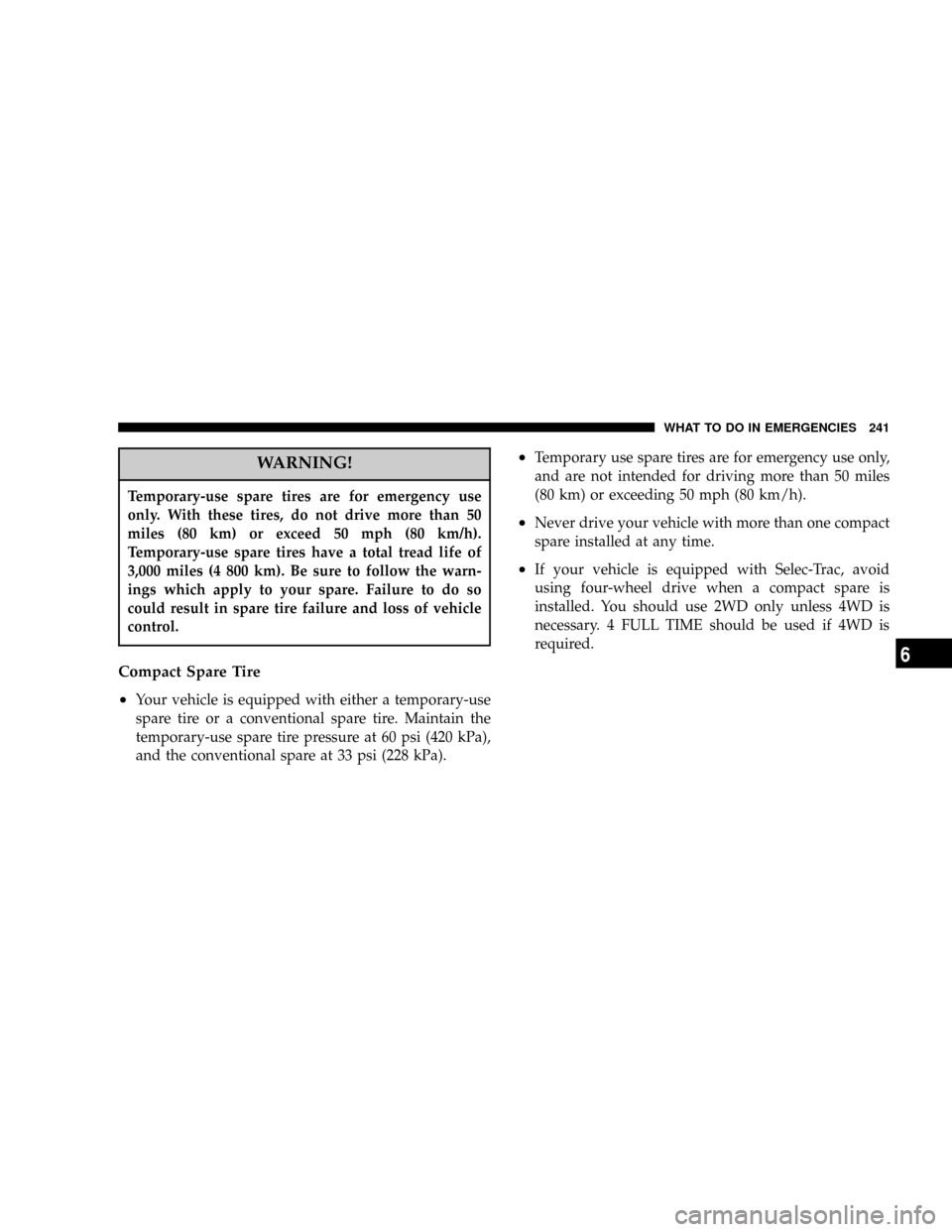
WARNING!
Temporary-use spare tires are for emergency use
only. With these tires, do not drive more than 50
miles (80 km) or exceed 50 mph (80 km/h).
Temporary-use spare tires have a total tread life of
3,000 miles (4 800 km). Be sure to follow the warn-
ings which apply to your spare. Failure to do so
could result in spare tire failure and loss of vehicle
control.
Compact Spare Tire
²
Your vehicle is equipped with either a temporary-use
spare tire or a conventional spare tire. Maintain the
temporary-use spare tire pressure at 60 psi (420 kPa),
and the conventional spare at 33 psi (228 kPa).
²Temporary use spare tires are for emergency use only,
and are not intended for driving more than 50 miles
(80 km) or exceeding 50 mph (80 km/h).
²Never drive your vehicle with more than one compact
spare installed at any time.
²If your vehicle is equipped with Selec-Trac, avoid
using four-wheel drive when a compact spare is
installed. You should use 2WD only unless 4WD is
necessary. 4 FULL TIME should be used if 4WD is
required.
WHAT TO DO IN EMERGENCIES 241
6
Page 242 of 344

Tire Changing Procedure
Preparation
WARNING!
You can be injured or killed if you try to change a
wheel too close to moving traffic. Pull far enough off
the road to avoid being hit when operating the jack
or changing the wheel.
²Park on a firm, level surface well off the road to
provide ample work space. Put the transmission in P
(Park) and stop the engine. Set the parking brake
firmly and activate the hazard warning flasher.
Avoid jacking up the vehicle with occupants inside. If
the jack should fall, someone in the vehicle could be
hurt.
²Block the front and rear of the
diagonally opposite tire. For
example, if the right front tire
is being changed, block the
left rear wheel.
Instructions
1. Remove the spare tire from under the cargo floor, jack
and jack tools from under the left and right rear seat.
2. Loosen the lug nuts one-half turn counterclockwise.
3. Assemble the jack and jacking tools as shown. Connect
jack handle driver (A) to extension (B), then to the lug
wrench (C).
242 WHAT TO DO IN EMERGENCIES
Page 243 of 344

4. Locate the jack as shown. For the front axle, place it
under the axle near the wheel to be changed. For the rear
axle, place it under the axle as shown.Front Jacking Location
WHAT TO DO IN EMERGENCIES 243
6
Page 244 of 344
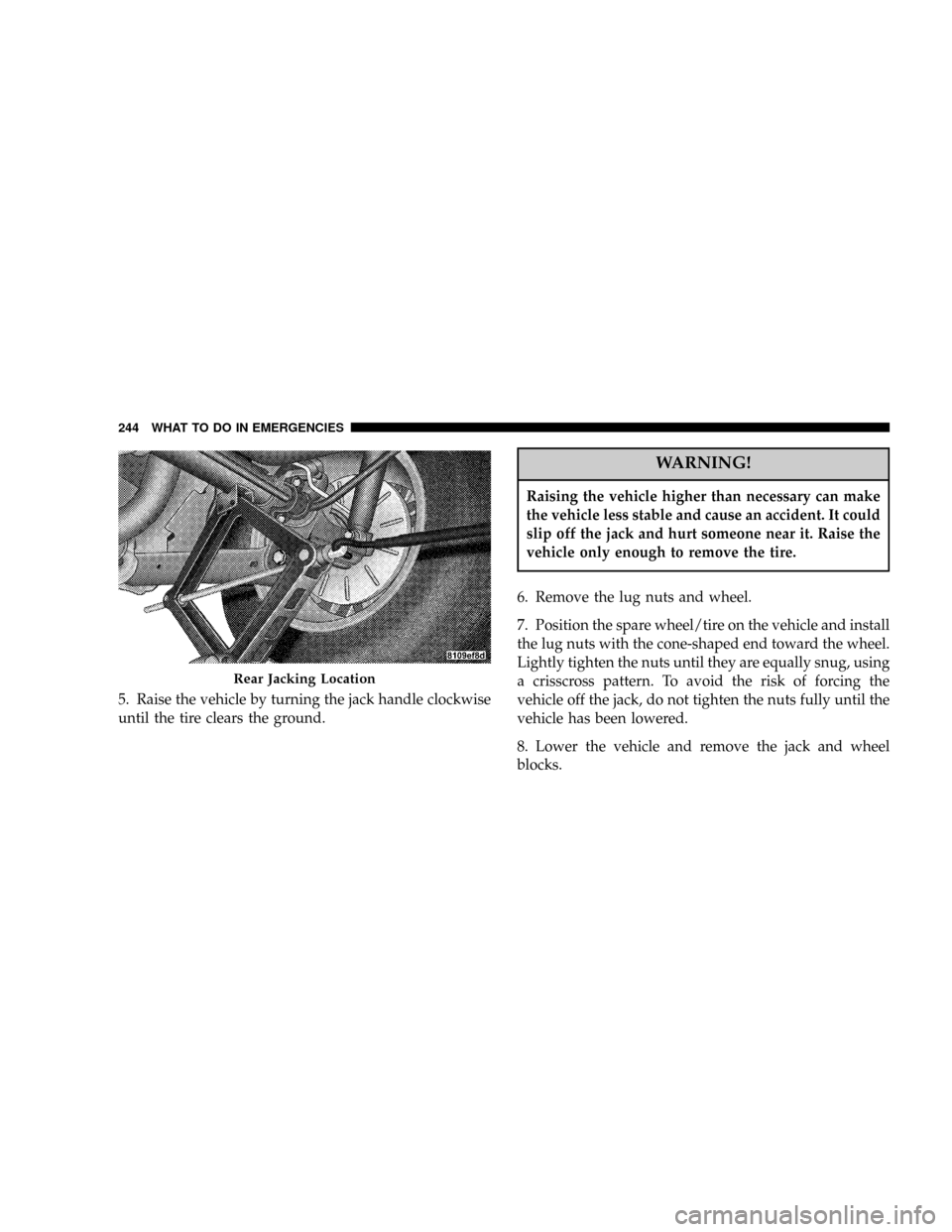
5. Raise the vehicle by turning the jack handle clockwise
until the tire clears the ground.
WARNING!
Raising the vehicle higher than necessary can make
the vehicle less stable and cause an accident. It could
slip off the jack and hurt someone near it. Raise the
vehicle only enough to remove the tire.
6. Remove the lug nuts and wheel.
7. Position the spare wheel/tire on the vehicle and install
the lug nuts with the cone-shaped end toward the wheel.
Lightly tighten the nuts until they are equally snug, using
a crisscross pattern. To avoid the risk of forcing the
vehicle off the jack, do not tighten the nuts fully until the
vehicle has been lowered.
8. Lower the vehicle and remove the jack and wheel
blocks.
Rear Jacking Location
244 WHAT TO DO IN EMERGENCIES
Page 245 of 344
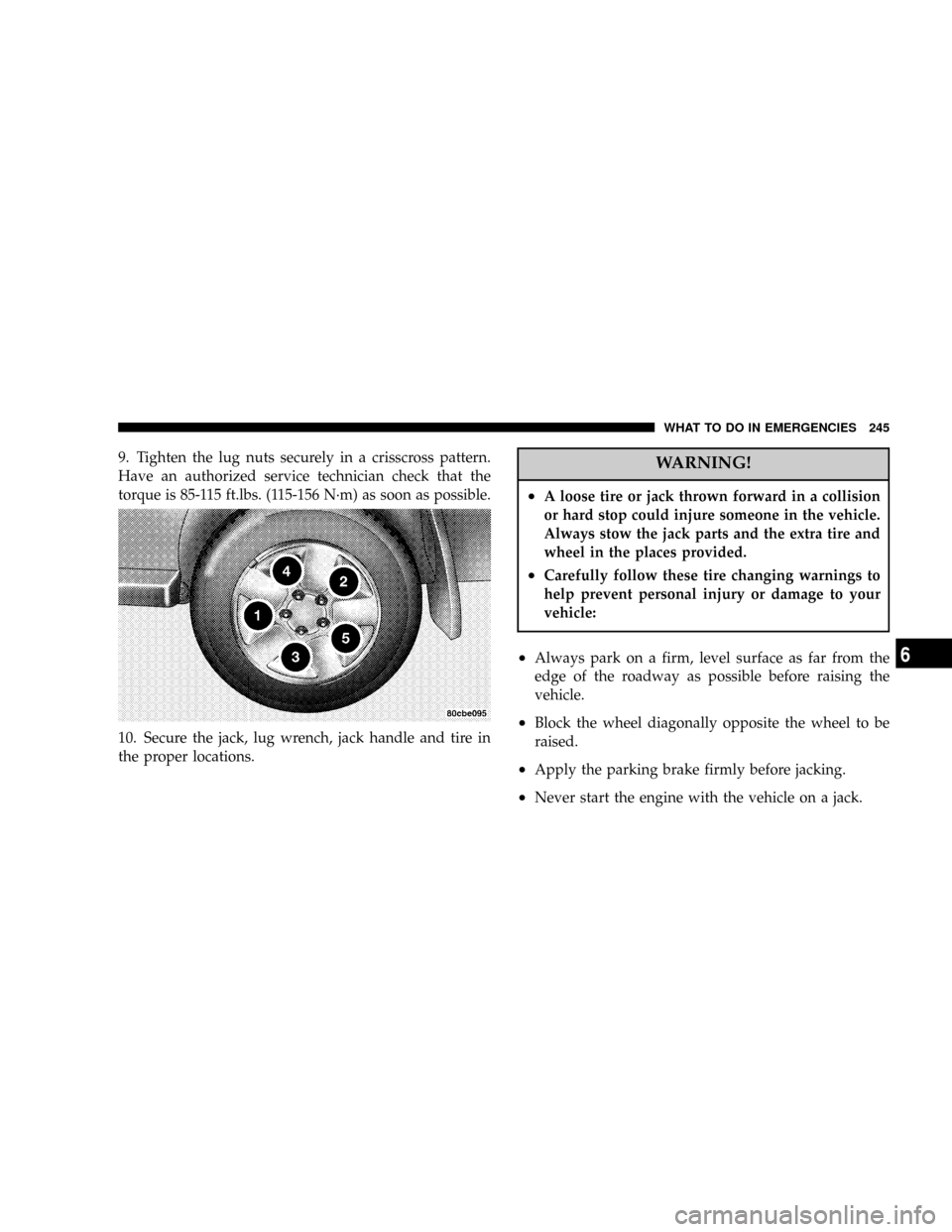
9. Tighten the lug nuts securely in a crisscross pattern.
Have an authorized service technician check that the
torque is 85-115 ft.lbs. (115-156 N´m) as soon as possible.
10. Secure the jack, lug wrench, jack handle and tire in
the proper locations.WARNING!
²A loose tire or jack thrown forward in a collision
or hard stop could injure someone in the vehicle.
Always stow the jack parts and the extra tire and
wheel in the places provided.
²Carefully follow these tire changing warnings to
help prevent personal injury or damage to your
vehicle:
²Always park on a firm, level surface as far from the
edge of the roadway as possible before raising the
vehicle.
²Block the wheel diagonally opposite the wheel to be
raised.
²Apply the parking brake firmly before jacking.
²Never start the engine with the vehicle on a jack.
WHAT TO DO IN EMERGENCIES 245
6
Page 246 of 344

²Do not let anyone sit in the vehicle when it is on a jack.
²Do not get under the vehicle when it is on a jack.
²Only use the jack in the positions indicated.
²If working on or near a roadway, be extremely careful
of motor traffic.
JUMP STARTING PROCEDURE
NOTE:Check the charge indicator on top of the battery.
If the indicator is light or yellow, replace the battery.
1. Wear eye protection and remove any metal jewelry
such as watch bands or bracelets that might make an
unintended electrical contact.
2. When boost is provided by a battery in another
vehicle, park that vehicle within booster cable reach but
without letting the vehicles touch. Set the parking brake,
place the transmission in P (Park), and turn the ignition
to OFF for both vehicles.3. Turn off the heater, radio and all unnecessary electrical
loads.
4. Connect one end of a jumper cable to the positive
terminal of the discharged battery. Connect the other end
of the same cable to the positive terminal of the booster
battery.
5. Connect the other cable, first to the negative terminal
of the booster battery and then connect the other end to
a non-paint metal surface on the engine of the vehicle
with the discharged battery. Make sure you have a good
contact on the engine.
6. Start the engine in the vehicle which has the booster
battery, let the engine idle a few minutes, then start the
engine in the vehicle with the discharged battery.
7. When removing the jumper cables, reverse the above
sequence exactly. Be careful of the moving belts and fan.
246 WHAT TO DO IN EMERGENCIES
Page 247 of 344
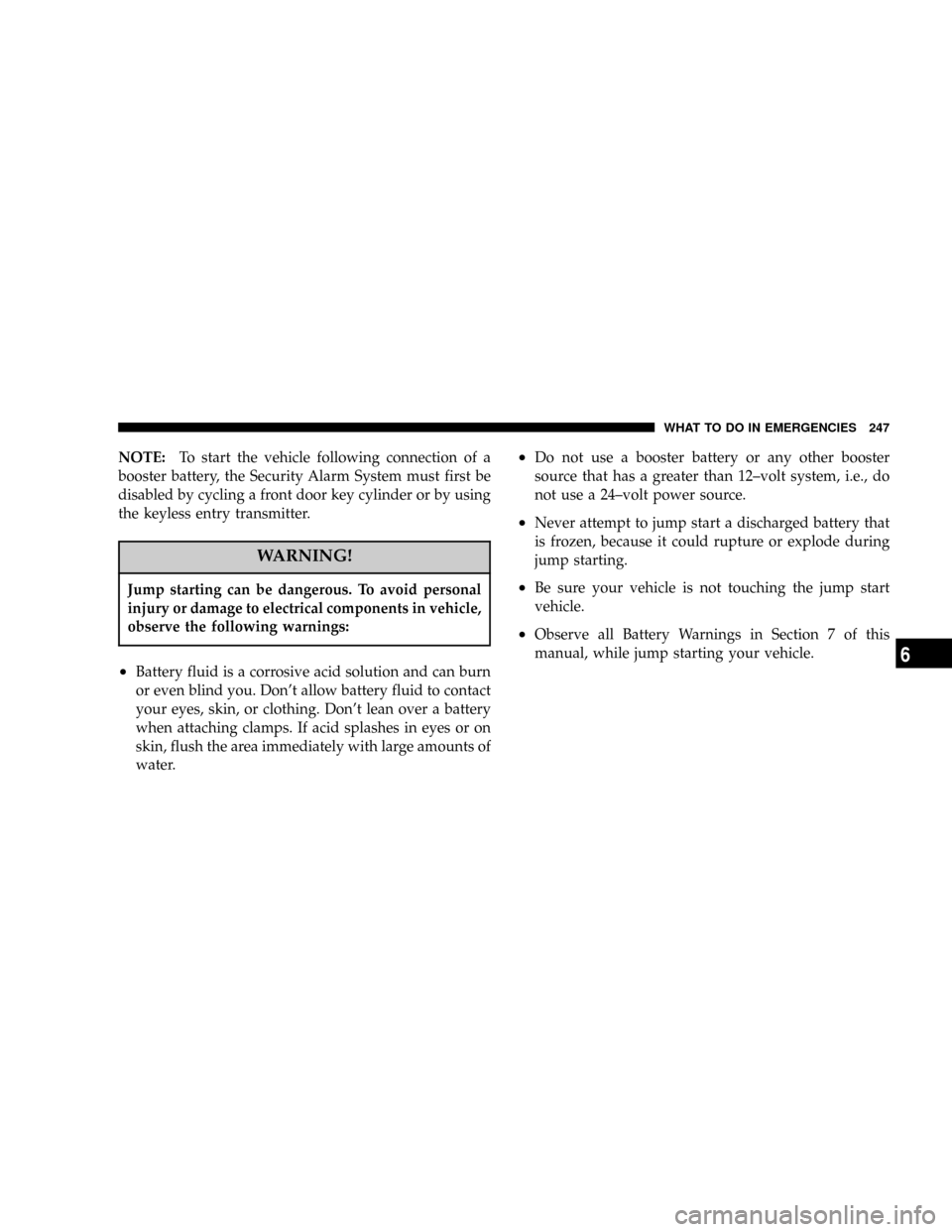
NOTE:To start the vehicle following connection of a
booster battery, the Security Alarm System must first be
disabled by cycling a front door key cylinder or by using
the keyless entry transmitter.
WARNING!
Jump starting can be dangerous. To avoid personal
injury or damage to electrical components in vehicle,
observe the following warnings:
²Battery fluid is a corrosive acid solution and can burn
or even blind you. Don't allow battery fluid to contact
your eyes, skin, or clothing. Don't lean over a battery
when attaching clamps. If acid splashes in eyes or on
skin, flush the area immediately with large amounts of
water.
²Do not use a booster battery or any other booster
source that has a greater than 12±volt system, i.e., do
not use a 24±volt power source.
²Never attempt to jump start a discharged battery that
is frozen, because it could rupture or explode during
jump starting.
²Be sure your vehicle is not touching the jump start
vehicle.
²Observe all Battery Warnings in Section 7 of this
manual, while jump starting your vehicle.
WHAT TO DO IN EMERGENCIES 247
6
Page 248 of 344
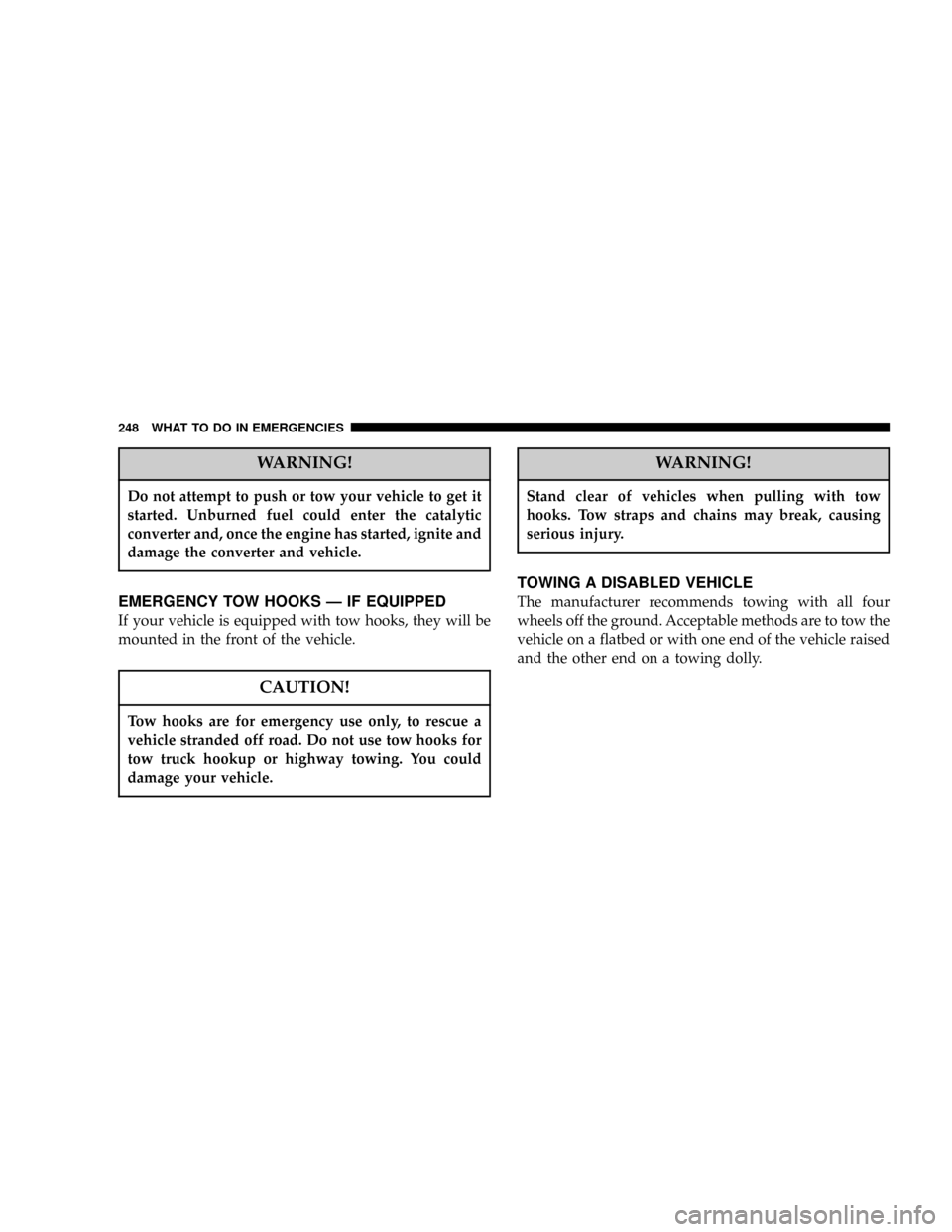
WARNING!
Do not attempt to push or tow your vehicle to get it
started. Unburned fuel could enter the catalytic
converter and, once the engine has started, ignite and
damage the converter and vehicle.
EMERGENCY TOW HOOKS Ð IF EQUIPPED
If your vehicle is equipped with tow hooks, they will be
mounted in the front of the vehicle.
CAUTION!
Tow hooks are for emergency use only, to rescue a
vehicle stranded off road. Do not use tow hooks for
tow truck hookup or highway towing. You could
damage your vehicle.
WARNING!
Stand clear of vehicles when pulling with tow
hooks. Tow straps and chains may break, causing
serious injury.
TOWING A DISABLED VEHICLE
The manufacturer recommends towing with all four
wheels off the ground. Acceptable methods are to tow the
vehicle on a flatbed or with one end of the vehicle raised
and the other end on a towing dolly.
248 WHAT TO DO IN EMERGENCIES
Page 249 of 344

MAINTAINING YOUR VEHICLE
CONTENTS
m4.0L Engine...........................251
m4.7L/4.7 HO Engine.....................252
mOnboard Diagnostic System Ð OBD II........253
mEmissions Inspection And Maintenance
Programs............................254
mReplacement Parts......................255
mDealer Service.........................255
mMaintenance Procedures..................256
NEngine Oil..........................256NDrive Belts - Check Condition And Tension . . . 261
NSpark Plugs.........................261
NCatalytic Converter....................261
NCrankcase Emission Control System........263
NFuel Filter..........................263
NAir Cleaner Filter.....................264
NMaintenance-Free Battery................264
NAir Conditioner Maintenance.............265
NPower Steering Fluid Check..............266
7
Page 250 of 344

NDriveline And Steering Component
Lubrication..........................267
NBody Lubrication.....................267
NWindshield Wiper Blades................268
NWindshield Washers Ð Front And Rear.....268
NExhaust System......................269
NCooling System.......................269
NHoses And Vacuum/Vapor Harnesses.......274
NBrake System........................274
NAutomatic Transmission................277
NTransfer Case........................280
NFront/Rear Axle Fluid..................281NAppearance Care And Protection From
Corrosion...........................281
mFuse Panel...........................286
NInterior Fuses........................286
NUnderhood Fuses
(Power Distribution Center)..............288
mVehicle Storage........................289
mReplacement Bulbs......................289
mFluid Capacities........................291
mRecommended Fluids, Lubricants And Genuine
Parts................................292
NEngine.............................292
NChassis............................293
250 MAINTAINING YOUR VEHICLE